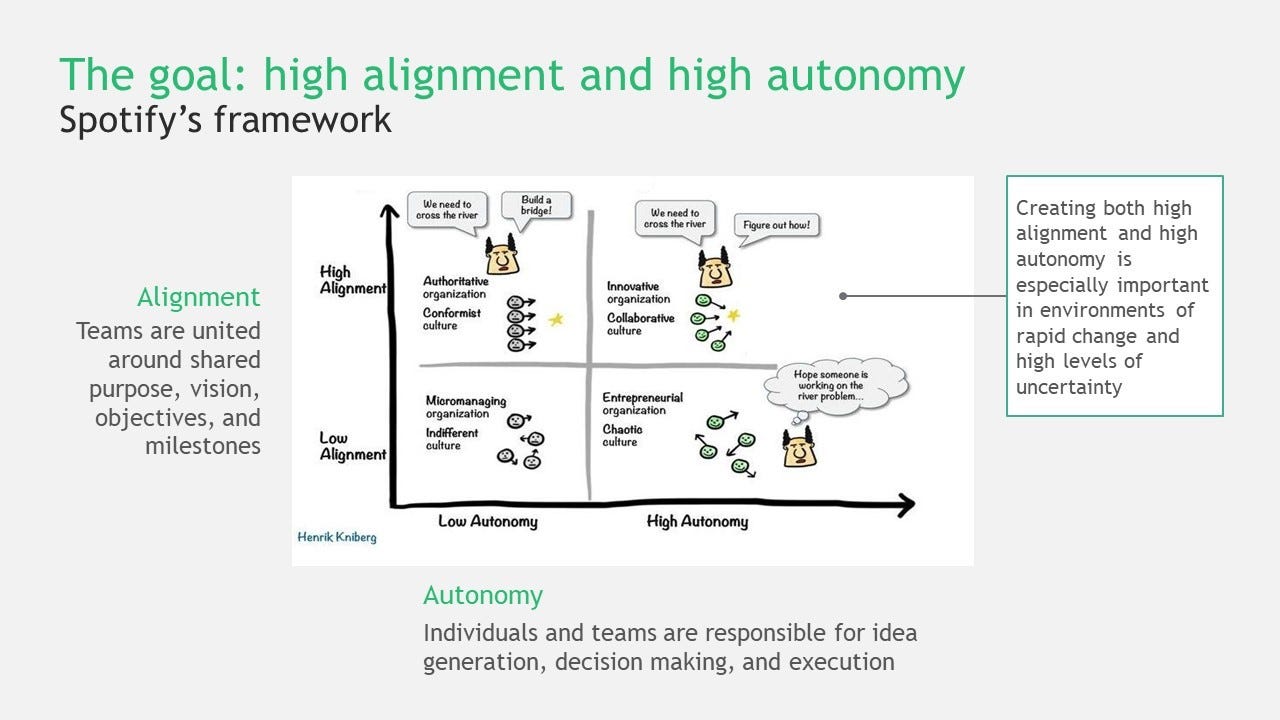Jim Hemerling
Managing Director & Senior Partner at Boston Consulting Group
Published on September 21, 2021
Great performance was once the hallmark of a successful company.
But great is no longer good enough, and companies need a new playbook.
Our recently published book Beyond Great is that playbook, exploring nine strategies that can help great companies contend with today’s complex forces, along with six imperatives for leaders as they work to take their companies beyond great.
In this article, I’m focusing on the imperative to shift from command and control to alignment and autonomy.
In the business world of the past-when leaders could count on a proven playbook and a certain amount of stability-leading by command and control enabled many leaders to deliver “great” performance.
Leaders set the direction, commanded people to follow it, and instilled a set of controls to ensure that employees complied.
But that’s not the world we’re in now.
To survive and thrive in today’s volatile, unpredictable environment, with fickle customers and employees demanding more from companies, leaders need to break with the past and take a much more open and collaborative approach.
To survive and thrive in today’s volatile, unpredictable environment, with fickle customers and employees demanding more from companies, leaders need to break with the past and take a much more open and collaborative approach.
To survive and thrive in today’s volatile, unpredictable environment, with fickle customers and employees demanding more from companies, leaders need to break with the past and take a much more open and collaborative approach.
… leaders need to break with the past and take a much more open and collaborative approach.
To illustrate this idea, I’d like to share Spotify’s framework, which has become a favorite in the business world, even though it’s still not put into practice often enough:

The command-and-control approach-the top-left corner-is embraced by an authoritative organization based on a conformist culture.
Many of today’s leaders were led that way when they were starting out. It’s what they know. While few leaders today would describe themselves as having a command-and-control approach, many continue to exhibit those deeply embedded traits.
The bottom-right corner is a reaction, often an overreaction, to that approach an acknowledgment that the most innovative, entrepreneurial teams need to be empowered and autonomous to be effective.
But a highly autonomous culture can lead to chaotic results, with too much independent freedom among employees to build a thriving, focused organization.
Finding the Leadership Sweet Spot
The sweet spot, of course, is to get to the top right: high alignment and high autonomy. It’s an essential approach as leaders contend with today’s disruptive forces and try to lead a company beyond great.
- Leaders build alignment in part by articulating and activating an inspiring purpose, envisioning and clarifying the future direction, and providing helpful guideposts, including clear objectives and milestones, while also being good communicators.
- To create conditions for autonomy, they can empower employees by coaching them while role modeling agile ways of working, establishing a workplace that enables them to take initiative and deliver outcomes.
- Beyond-great leaders are humble, freely admitting that they can’t know everything they need to know.
- Instead of exerting control over them and insisting they know the way, leaders can build the kind of adaptive, agile, and resilient organizations needed in a volatile world.
The Counterintuitive Benefits for Transformation
While somewhat counterintuitive, this approach to leadership is also highly effective when driving large-scale transformation programs.
One of the nine Beyond Great strategies is to “embrace always-on transformation”-particularly important when faced with the need to deliver a step-change in performance quickly in an environment of constant change.
At such times, leaders-even leaders who would normally embrace an approach of autonomy and empowerment in their day-to-day roles-often default to command-and-control behavior, as though it’s required for delivering transformational results in compressed timeframes.
This can result in rigid governance mechanisms, including approaches to defining, tracking, monitoring, and directing activities, in an attempt to exercise control.
But this a world of constant change, where the objectives of the transformation include not only executing cost reduction initiatives but developing and incubating innovative products, services, and business models that leverage digital technologies and data and analytics.
Teams need to execute while innovating-activities that thrive in an environment of alignment and autonomy and wither under the constraints of command and control.
While hitting the sweet spot of alignment and autonomy under the fast-paced demands of transformation is by no means easy to pull off, the benefits vastly outweigh the false security of command and control.
Roberto Marques, chairman and CEO of Brazilian cosmetics company Natura &Co, is a leader who exemplifies this kind of approach.
In our interviews with him for Beyond Great, he told my coauthors and me that no one can hope to have all the answers in a global environment that is changing as rapidly as ours.
Instead, leaders have to recruit others with the capacity to develop solutions, amplifying and expanding their efforts rather than directing them.
- He explained that being a leader today entails having the humility and self-awareness to acknowledge that you don’t have all the answers.
- You have to trust your teams and be able to communicate frankly with them, “reaching out to the organization in a way that will allow you to get information back that will help you make the right decisions and course correct when necessary.”
By becoming more collaborative and less directive, you will energize your teams and inspire their creativity.
The beyond-great journey isn’t an easy one.
But when leaders move away from the old habit of command and control, they can build a company that’s prepared to thrive in our volatile global business environment rather than remain imprisoned by it.
This is the third in a series of articles on leadership based on my recent book Beyond Great: Nine Strategies for Thriving in an Era of Social Tension, Economic Nationalism, and Technological Revolution, coauthored with my BCG colleagues Arindam Bhattacharya and Nikolaus Lang.
Please also see “Now Is the Time for Beyond Great Leadership” and “Beyond Great: Leading with a Conviction to Positively Impact Society.” I welcome your feedback.
Originally published at https://www.linkedin.com.
Names cited:
Roberto Marques, chairman and CEO of Brazilian cosmetics company Natura &Co;












